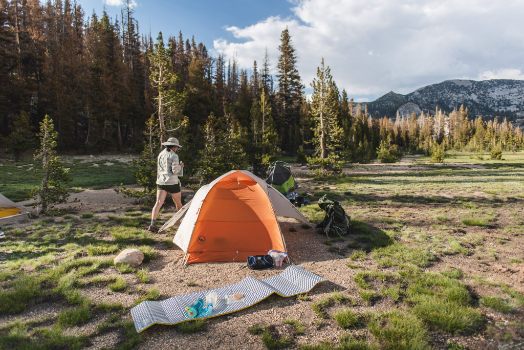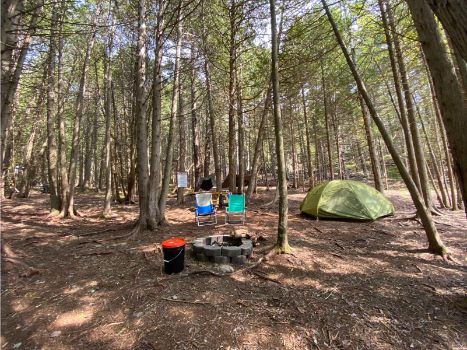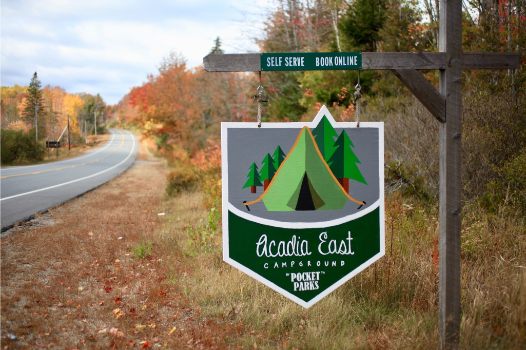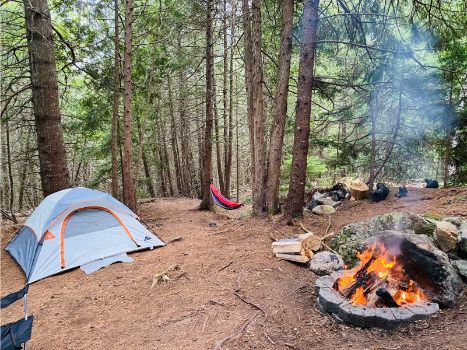This interview is with Tom Tash from Pocket Parks. Tom and 2 others established Pocket Parks with the goal of having self-serve tent campgrounds with online reservations. Acadia East Campground is the first campground to open on June 27, 2018. I wanted this opportunity to learn about how someone goes about opening a campground and to hear about the success that they’ve had thus far. Before the interview officially began we were having a good discussion about the lack of websites and blogs that were dedicated to tent camping, but that there are lots of sites devoted to living in an RV or doing light weight backpacking, etc. While these are nice to do, they become expensive due to the need/desire for light weight items (titanium spork for backpacking) or large trailers (ever priced a 5th wheel?). Tent camping is the ideal starting point for people to get into camping because it is inexpensive and easy to go on a whim. So let’s dive into the first part of my interview with Tom from Pocket Parks!

When did the idea of Pocket Parks come to you?
Tom: The wheels have been turning since about 18 months ago (January 2017), but it was about 3 years ago when I took a trip to the southwest with an expectation that I would get my gear and a rental car and head out for 8 days of unbelievable tent camping. But that didn’t happen. I showed up at Joshua Tree National Park (in California) and was told that I needed to make tent camping reservations 8 months in advance. Same thing at Death Valley, Scion, all of Utah’s national parks, Grand Canyon. I only ended up using the tent for 1 night just because a campground agreed to let me pitch the tent because of how late at night it was. It was a little disappointing…I didn’t really accomplish what I was hoping to from this trip.
On the flight back, I got to thinking that in a part of the country with all of this land that’s for sale, how is it that there aren’t more places to camp. Living near Acadia National Park (in Maine) makes it a bit different from out west where we don’t have the big national forests and the BLM (Bureau of Land Management) land and things like that, but most of the land is privately owned. There’s a real shortage of camping here as well, but I went looking around for some land to buy for a backcountry camping experience that would replicate what you would find inside the national park. It took about a year to find the right location for our first campground (Acadia East Campground), 9 acres just outside of Gouldsboro which is located near the Schoodic District of Acadia National Park. And here we are, we opened with 4 sites, we’ll have 8 by the end of the summer, and we’re hoping to have about 30 next year. It’s just a handful of sites but it provides lots of space so you can feel like you are deep in the woods and really have that national park experience.
Acadia East Campground is your first campground, located outside of Gouldsboro, Maine. How did you come to acquire this parcel for the campground?
Tom: To say that it was a unique experience is an understatement. Not only for us, but for the seller, for the realtors on both sides, for the town of Gouldsboro and their code enforcement team, and right up through the state. I’m not sure that there was a single person, ourselves included, that didn’t rub the back of their neck and say “I’m not sure what to do here.” That made it interesting, and that’s what this whole first location is about. It’s our pilot location and its close enough for us so that can do everything by hand and understand how the process works so that we can then take that and apply it for the future.
You can only do so much searching online, and I’m not sure about the rest of the country, but here in Maine we do things the old fashioned way. There’s so much land for sale that you would never see online, you just have to go out and drive and start making phone calls. We weren’t sure exactly what (we were looking for), but we knew that we’d know when we found it. When we found this property, the location was great, we were only 10 minutes from the big welcome sign to Acadia National Park at Schoodic. The area really lacked camping options, and its becoming a more highly visited section of the park in the last 2-3 years. There’s really only 3 campgrounds in 40 miles in any direction, so it was a great location. When we first walked the property it felt like we were in the park: large granite ledges, a lot of vertical changes, a lot of evergreen trees and a lot of wildlife.
We spoke with the planning board and expressed our intentions about what to do, and I think they were just excited. Its a very, very small community, so small that they hadn’t had a business application filed in about 5 years. When we did, they realized that it was outdated and we had to fill out a new application. Our specific (state) rep was just so excited about what we were doing. He was more hands-on than I would ever expect, and worked with us the entire way to help us figure out how we applied to existing guidelines.

Why did you elect to focus on your campgrounds catering to tent camping?
Tom: That kind of goes back to my childhood. Money was tight, opportunities to have recreational adventures were few and far between. When we did have them, they were spent at state campgrounds or these small, very rustic, lesser known camping areas. If we were going camping, it was always in a tent, it was the most affordable place we could find, and those were some of the best memories that I have. Some of these places where I remember tenting with friends near Acadia (National Park) were $45 for a tent site. Well today, most of those sites are $85 and up for a tent site. That’s just cost prohibitive. We’re kind of bringing a non-profit mentality to a for-profit business. For us its more important to develop future generations of people that want to be in tents. If that means that we’re the cheapest guy on the block so that we always have people there, and it gets younger people excited about being in tents, that’s only going to be better for us in the future as well. That’s the idea, that we really want to stick to one thing and try not to chase the trends too much. Right now we’re focusing on young couples, young families with children, and people that just want to affordably have a place they can call home base while they go see the beaches or hike the trails.
The name “Pocket Parks”, how did this come about?
Tom: This seems to be one of the more frequently asked questions. Part of my background in recreation was working for municipalities, so the term for me was like someone in business hearing the term “return on investment (ROI)”. Its one of those terms that you hear used all the time, but once I got out of that, I realized that most people didn’t know the term. So “Pocket Parks” is typically a name reserved for the small areas and community parks that municipalities stuff between buildings or street blocks. If you’re in a major metropolitan area and you come across a small park with a bench and small patch of grass, those are typically referred to as pocket parks. So we’re playing off that with the fact that we’re not looking at 200 acre campgrounds with 250 sites, RV hookups and all of that. For us, what can we do with 5 acres? Part of that is in our business model of scalability, being able to have multiple locations, but part of that is also the dynamic of where our country is regarding real estate. It’s difficult to find large swathes of land these days. Can we have 10 sites at the Grand Canyon? Can we have 8 sites near Mount Rushmore?
You mentioned that at Acadia East Campground you have about 9 acres, yet you are hoping for about 30 campsites?
Tom: Yeah, it would be right around 3 to 4 campsites per acre. Ultimately we let the land dictate how the campground looks. We try not to force anything and if it just doesn’t feel right we’d rather leave the land raw and unspoiled versus trying to cram another site into it. Currently you can’t see any site from any other site, and that’s really what we’re hoping to stay true to. We want people to be able to go there, have a nice quiet time and not feel that they will be disturbed by their neighbors. You’re only about 30 minutes to the main part of the National Park from us.

Can you explain how and why you came up with the tagline “Backcountry Style For Frontcountry Adventurers”?
Tom: That goes back to a previous life when I was working with the National Park Service. During that time I was also working with a national park mobile app travel company. Much of the content that was being developed (for the app) was being catered to the “frontcountry” guests which was the terminology they used for folks that would show up in an RV, pull right up to the side of the Grand Canyon, take a few photos, then hop back in and go find lunch. Sort of the afternoon visitor. And that was because everyone sort of figured that if you were a “backcountry” visitor, you knew what you wanted to do, you’ve done the research, you know where you’re going. 90% of visitors are sort of that frontcountry visitor, they aren’t walking more than a half-mile away from their vehicle during their visit.
We (Acadia East Campground) are right on Route 1. Route 1 is one of the largest, most popular corridors in the entire state, it runs right along the coastline, it’s sort of quintiscential Maine from top to bottom. We just happen to be on a really quiet stretch of it. Right from Route 1 you pull directly into our parking area, and once you get 20 feet up into the woods on our camping trail, you may as well be in the north country. So that’s the idea, you can sort of dip your toes in the water of what it would be like to really camp out in the woods, where you’ll see actual wildlife and you’re not going to hear a lot of people, but in 5 minutes you can be back in your car heading to get a burger.
You have focused on locating your campgrounds near national parks. Can you explain why you’ve chosen to do this?
Tom: The park service is in a bit of a predicament these days. Interest and visitation has never been higher, and every year it continues to increase, which continues to put strain on the facilities. Their budget and their maintenance backlog makes it difficult for them to truly be able to offer a great experience for visitors. It would be laughable to suggest that we’re helping to fix that problem, but a few more people will be able to stay than would otherwise be able to. So that’s kind of a big piece for us.
Those (national parks) are really the premier brand of outdoor recreation destination in America, so it seemed like a good place to start. If we hit all 59 national parks, minus maybe some of the most northern Alaska ones, then we may start looking at places like the Ozarks or the Adirondacks, Lake Tahoe and other great outdoor recreation destinations. But this will probably keep us busy for quite a while.

Wrap Up
Tom Tash and his crew have started a great series of campgrounds outside of our great national parks. I found the conversation extremely enjoyable and Tom is very knowledgeable and passionate. Tent camping is an accessible form of recreation, and Pocket Parks maintains this tradition with affordable prices and great sites. In 2 weeks we’ll have the second part of my interview, but in the mean time check out our other interview with newly weds who chose tent camping for their honeymoon – You Did What For Your Honeymoon?!
If you want to get into tent camping or take your skills to the next level and how to best outfit yourself with the right gear, check out my best-selling book “The Best Tent Camping Guide”.
